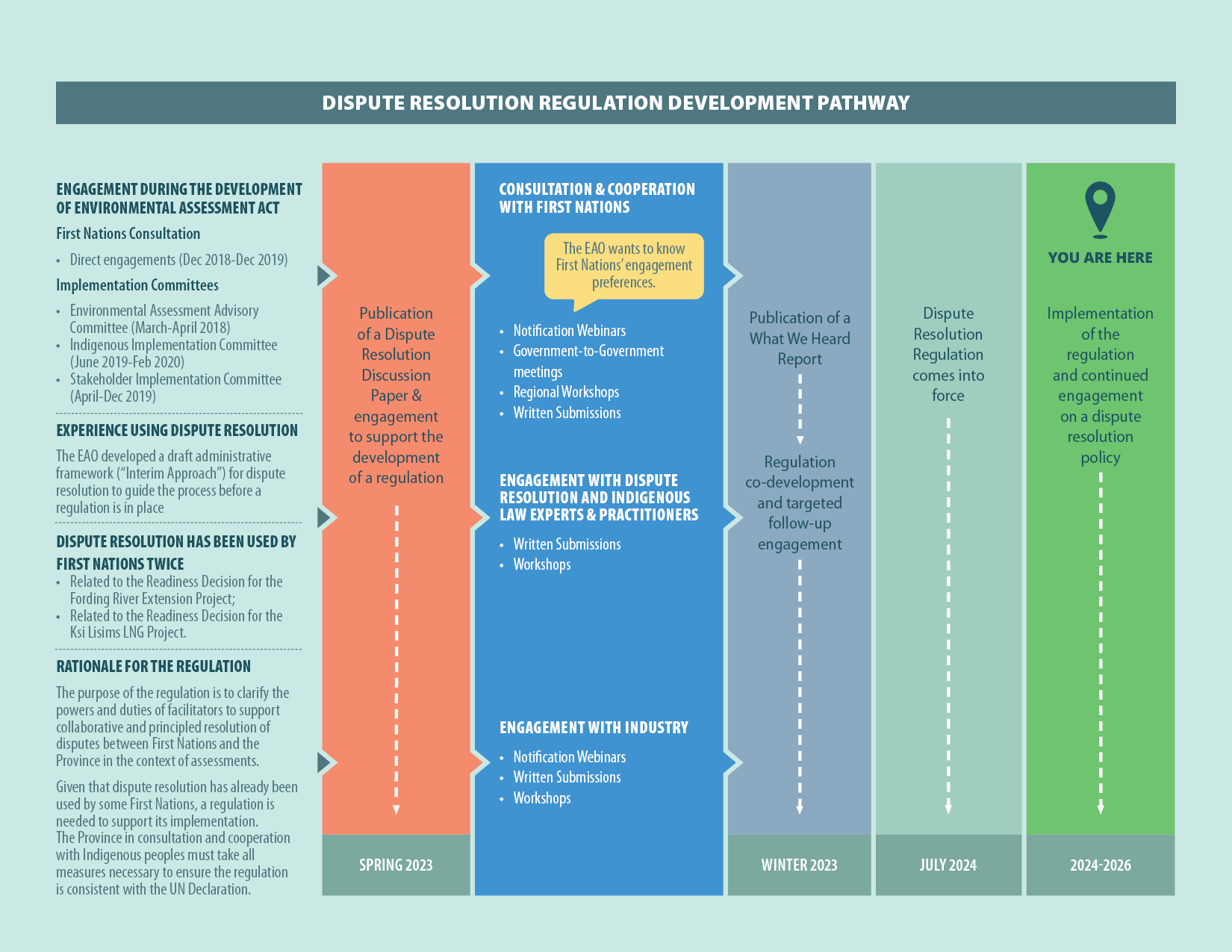Dispute resolution with First Nations
Revising Dispute Resolution in Environmental Assessments
The Environmental Assessment Office (EAO) is currently engaging on the first area of focus for its legislated review of the Environmental Assessment Act – dispute resolution. Experiences with dispute resolution processes have shown that while it has the potential as a valuable tool, the intended outcomes are not being met.
Discussion Paper: Revising Dispute Resolution in Environmental Assessments
Learn more and find out how you can get involved in the EAO’s review of the dispute resolution framework.
Supporting reconciliation with First Nations is a key purpose of the Environmental Assessment Office. The EAO collaborates with First Nations throughout the assessment process and involves First Nations in the decision-making on projects that may affect them.
The EAO seeks consensus with First Nations at key points in the environmental assessment process. There may be times at decision points within the environmental assessment process where, despite efforts of First Nations and the EAO to reach consensus, decisions are not aligned, and consensus is not reached. Dispute resolution was implementd as a tool to support consensus-seeking and building good relations between governments. It provides for a collaborative and principled process to resolve the dispute consistent with the United Nations Declaration on the Rights of Indigenous Peoples.
On this page
- Development of current framework
- Early experience using dispute resolution
- Regulation development pathway
- Contact us about dispute resolution
Current regulatory framework
On July 9, 2024, the Environmental Assessment Dispute Resolution Facilitators Regulation came into force. The regulation provides clear guidelines to support a process of dialogue and negotiation to build respectful relations between the EAO and First Nations. Read the news release for more information.
Under the Environmental Assessment Act, dispute resolution is available at key decision points in the environmental assessment process. An experienced, third-party facilitator may be appointed to help guide the EAO and participating First Nations when they are unable to reach consensus on their own.
The Environmental Assessment Act defines specific elements of dispute resolution, including who can use dispute resolution and the types of disputes that can go to a facilitator. The regulation defines the powers and obligations of facilitators. For example, this includes an obligation to support the parties to co-develop a customized facilitation process that gives due consideration to the customs, traditions and legal systems of First Nations, and a power to end a facilitation in certain circumstances under certain conditions.
The regulation is just one piece to support the implementation of dispute resolution. A broader framework of policy, guidance, and tools supports implementation. During the consult and cooperate process, the EAO heard a wealth of information beyond what could be captured in the regulation. That feedback will inform next steps in policy development.
The policy framework aims to:
- Be consistent with the UN Declaration on the Rights of Indigenous Peoples
- Support collaborative and principled resolution of disputes
- Create clarity, consistency, and predictability in the dispute resolution process
Development of current framework
To support consultation and cooperation on the development of the regulation, the EAO developed tools that explored aspects of dispute resolution.
- Environmental Assessment Dispute Resolution Facilitators Regulation
- Dispute Resolution Discussion Paper (PDF, 1.7 mb)
- Interim Approach (PDF, 1.3 mb)
- Interim Guidelines for Facilitators (PDF, 325 kb)
- What We Heard and Summary of Engagement (PDF, 4.5 mb)
Early experience with dispute resolution
Prior to the new regulation took effect in 2024 dispute resolution was used twice after the Environmental Assessment Act came into force in 2019. In absence of a dispute resolution regulation, the EAO used an interim approach to dispute resolution, to guide the dispute resolution processes initiated while the regulation is under development.
- Fording River Extension Project – Dispute Resolution Facilitator’s Report (PDF, 1.7 mb)
- Fording River Extension Project – Dispute Resolution Implementation Feedback Report (PDF, 711 kb)
- Ksi Lisims LNG – Dispute Resolution Facilitator’s Report (PDF, 1.3 mb)
Find additional dispute resolution documents on the EAO's Project Information Centre here.
Regulation development pathway
To support the development of the dispute resolution regulation, the EAO held workshops in consultation and cooperation with First Nations and engagement sessions with industry representatives during summer 2023. Participants were invited to attend in-person or virtual meetings, and to submit written submissions.
Submissions from First Nations
- Doig River First Nation
- First Nations Leadership Council
- Gitga’at First Nation
- Halalt First Nation
- Kitselas First Nation
- Ktunaxa Nation Council
- Lake Babine Nation
- Maa-nulth Treaty Society
- Musqueam Indian Band
- Nuxalk Nation
- Tsleil-Waututh Nation
Submissions from Industry
- Canadian Association of Petroleum Producers
- Ksi Lisims LNG
- Mining Association of British Columbia
- Teck Resources Limited
A What We Heard and Summary of Engagement report summarizes feedback that the EAO received from First Nations and industry through written submissions, workshops, and government-to-government meetings.
Taking all the feedback that was received into account, the EAO worked with eight First Nations partners to co-develop the regulation.

Contact us
If you have questions or comments about dispute resolution, please get in touch at: EAO.DisputeResolution@gov.bc.ca.
